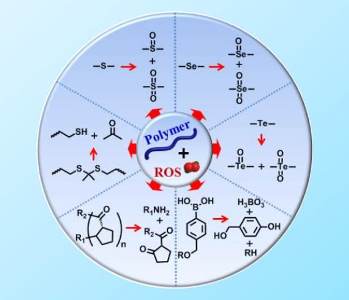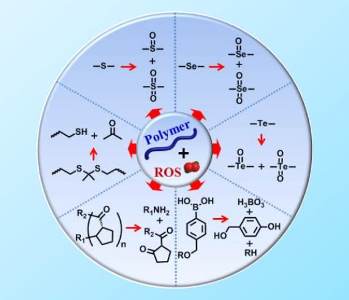 Stimuli-responsive polymers can undergo changes in chemical structure, biochemical or physical properties in response to environmental stimuli such as light, pH, temperature and ionic strength. Among these responsive polymers, redox-responsive materials have received considerable attention and especially polymers capable of responding to cell-generated reactive oxygen species (ROS) represent an emerging type of materials for biomedical and biotechnology applications.
Stimuli-responsive polymers can undergo changes in chemical structure, biochemical or physical properties in response to environmental stimuli such as light, pH, temperature and ionic strength. Among these responsive polymers, redox-responsive materials have received considerable attention and especially polymers capable of responding to cell-generated reactive oxygen species (ROS) represent an emerging type of materials for biomedical and biotechnology applications.
ROS play a crucial role in cell signaling pathways and are omnipresent in living organisms. Initially thought of toxic by-products of the aerobic metabolism, ROS have recently been recognized to play a crucial role in cell signaling pathways. During normal metabolic activity, a delicate balance between ROS generation and elimination has to be maintained. However, an increased production of ROS unable to be neutralized by antioxidants in cells can lead to a disruption of cellular homeostasis, and impairs cell components like membrane lipids, proteins and DNA. Oxidation-responsive polymers can respond to ROS with variations in solubility and induced degradation. They have a high potential for ROS sensing and elimination, drug and gene delivery as well as cell protection against oxidative stress.
In a recent review by Chen and co-workers, different kinds of representative chemical motifs with ROS responsive properties are summarized. These motifs can be included in many different oxidation-responsive polymers able to self-assemble into nanoparticles or form macroscopic scaffolds. The oxidation-responsive behavior of these polymeric platforms in different microenvironments as well as biomedical applications such as drug delivery, tissue engineering and anti-oxidation effects in vivo are discussed and highlighted. ROS-responsive polymers are attractive biomaterials to intelligently interact with complex biological signals and a range of new materials has been designed and evaluated for biomedical applications.

















